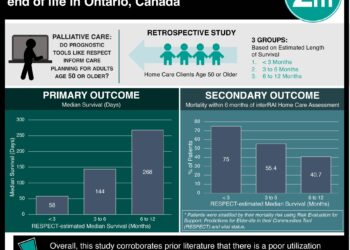Increasing proxy-reported pain at end-of-life from 1998-2010
1. In this prospective cohort study, proxy-reported prevalence of pain at the end-of-life increased between 1998 and 2010.
2. Prevalence of proxy-reported depression, periodic confusion and incontinence also increased during this time.
Evidence Rating Level: 2 (Good)
Study Rundown: In the last two decades, increased focus on symptom management at the end-of-life has generated numerous recommendations and policies to improve comfort for dying patients and their families. Yet, it is unclear what effect these changes have had on the patient experience at the end-of-life. This analysis used data from a long-term study, conducted from 1998-2010, of adults who were followed every two years until death. Following death, a patient proxy (e.g., a spouse or child) was interviewed regarding the patient’s symptoms during the last year of life. Unfortunately, prevalence of symptoms was high at the end-of-life, and reports of pain, depression and periodic confusion increased gradually during the study period. Notably, patients with cancer were excepted from this trend – prevalence of symptoms did not increase among this group. The primary limitation of this study was the method of data collection – proxies were interviewed up to two years following the patient’s death, and their descriptions are subject to recall bias. Changes in prevalence of symptoms could also have reflected proxies’ changing notice of these symptoms or willingness to report them. Nevertheless, these results suggest a troubling trend of worsening symptom management during the last year of life between 1998 and 2010, despite local and national efforts to improve the experience of dying.
Click to read the study, published today in AIM
Relevant Reading: Approaching Death: Improving Care at the End of Life
In-Depth [prospective cohort study]: This investigation analyzed results from 7,204 patients enrolled in the Health and Retirement Study who died between 1998 and 2010. Patients were interviewed every two years until time of death, and then a patient proxy was interviewed within two years of the patient’s death. Symptom prevalence was computed for two-year blocks during this period, and was then adjusted for a number of patient-related, proxy-related, and care-related variables. Overall, in the fully adjusted model, prevalence of any pain increased 11.9% (95%CI 3.1-21.4%), depression increased 26.6% (95%CI 14.5-40.1%), periodic confusion increased 31.3% (95%CI 18.6-45.1%), and incontinence increased 11.9% (95%CI 1.0-23.6%) between 1998 and 2010. According to this model, 60.8% of patients who died in 2010 (95%CI 58.2-63.4%) were “often troubled” with pain during the last year of life. Although potentially confounded by reporting bias, these results demonstrate that pain, depression, and other symptoms remain highly prevalent at the end-of-life, and that there remains much work to be done in addressing these shortcomings in care provision.
More from this author: Midlife diabetes associated with cognitive decline, Atrial fibrillation likely increases risk of silent strokes, HIV rebound observed after therapeutic stem cell transplant, USPSTF recommends behavioral counseling to reduce cardiovascular disease, ACP recommends non-pharmacologic treatment of urinary incontinence in women
Image: CC/GNU Free
©2015 2 Minute Medicine, Inc. All rights reserved. No works may be reproduced without expressed written consent from 2 Minute Medicine, Inc. No article should be construed as medical advice and is not intended as such by the authors, editors, staff or by 2 Minute Medicine, Inc.





![Vaccines for predicted influenza strains may provide wide protection [PreClinical]](https://www.2minutemedicine.com/wp-content/uploads/2014/11/18156_lores-75x75.jpg)

